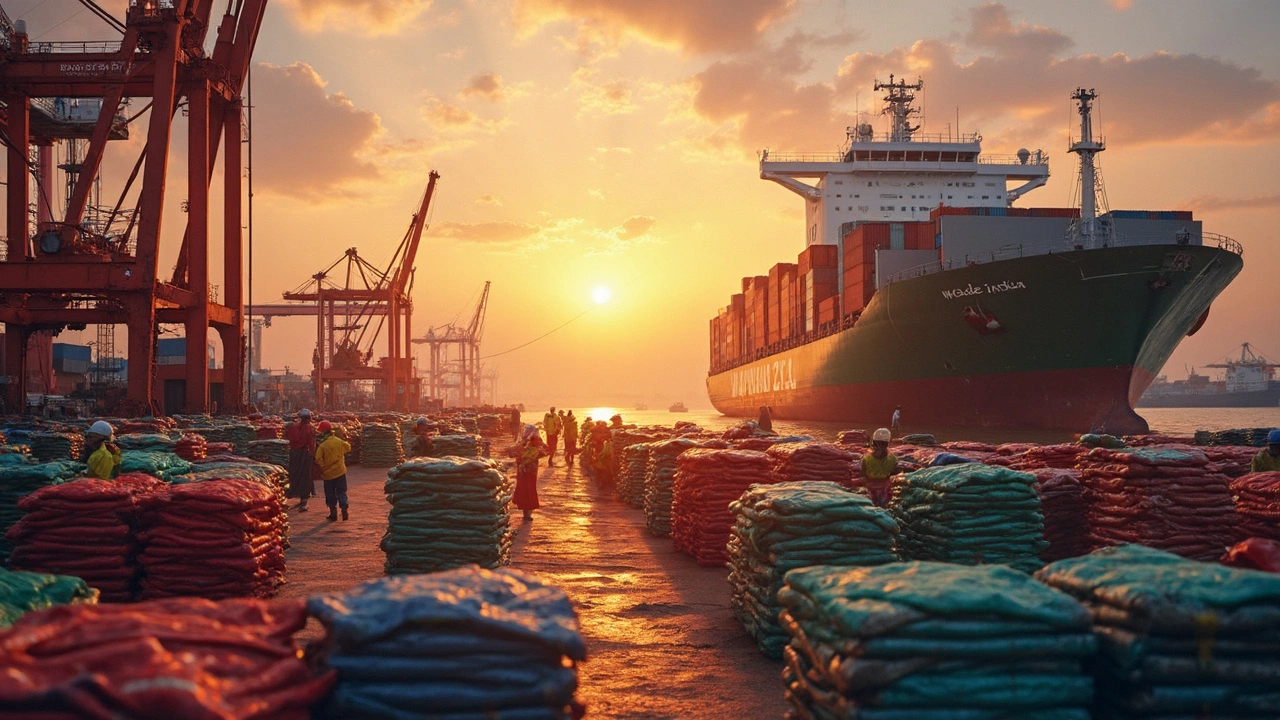Ask ten people what India sells to the world the most, and you’ll probably hear guesses like tea, clothes, or maybe those spicy snacks. Most people miss the real answer—it’s petroleum products. We’re talking diesel, petrol, and other refined fuels. Not the most glamorous product, but it’s the biggest moneymaker. Just last year, petroleum exports pulled in over $90 billion, making India one of the top fuel exporters globally.
What does this mean if you’re in the export business, or want to be? First, there’s huge global demand, especially from countries that don’t have refineries of their own. If you follow the news, you know that refinery giants like Reliance Industries are big players, shipping fuel to places like the U.S., the Middle East, and Africa. And because crude oil prices swing up and down so much, being in the petroleum export game means you need to pay close attention to global markets and regulations.
- India’s Export Scene at a Glance
- The Reigning Champion: Most Sold Item Explained
- Why This Product Leads
- Top Destinations: Who’s Buying Most?
- Profit Potential & Challenges
- Tips for Starting Out in Exporting This Item
India’s Export Scene at a Glance
When people talk about India’s global trade, they usually picture spices or fancy textiles. But the real action is way bigger. The country’s export business has been breaking records, with total exports hitting close to $775 billion in the 2023–24 financial year. That includes both goods and services, but let’s stick to just products for now.
Here’s what stands out: Indian exports are incredibly diverse. Aside from petroleum products, India’s shelves for the world are stacked with gems, jewelry, pharmaceuticals, engineering goods, and even cars. People in Europe, Africa, the U.S., and the Middle East all buy India’s most sold items.
| Top Export Products (2023–24) | Share of Goods Exports |
|---|---|
| Petroleum Products | 21% |
| Gems & Jewelry | 9% |
| Pharmaceuticals | 6% |
| Engineering Goods | 14% |
| Textiles | 6% |
The engines behind these numbers? Massive refineries, IT wizards, farm product exporters, and a push from the government for ‘Make in India’ and trade deals. That’s why India is always climbing the ladder, now sitting among the world’s top exporters for a bunch of categories.
For anyone thinking about the export business in India, you can see there’s more opportunity than ever. The variety covers not just big industries but smaller, niche areas too. If you’re aiming to crack into exports, keeping an eye on what’s hot and the changing rules can give you an edge.
The Reigning Champion: Most Sold Item Explained
When it comes to the most sold item India ships out, it’s not gadgets or garments—it’s petroleum products. India exports a huge volume of things like diesel, jet fuel, petrol, and specialty chemicals made from crude oil. This all starts at giant refineries like Reliance Industries' Jamnagar site. In fact, Jamnagar is the world’s largest oil refinery, and it alone pumps out millions of barrels every day for export.
You might think only oil-rich nations can do this, but here’s the twist: India actually imports crude oil, refines it at home, and then sends the high-value, cleaner fuels abroad. That means even though India doesn’t have a ton of natural oil, the real money comes from its world-class refining facilities.
Take a look at these up-to-date numbers:
| Year | Petroleum Export Value (USD Billion) | % of Total Indian Exports |
|---|---|---|
| 2022-2023 | 94 | 17% |
| 2023-2024 | 90 | 16% |
This means nearly a fifth of everything India sells across the globe is fuel-based. The steady demand comes from everywhere—Asia, the Middle East, Africa, even Europe grabs a share. Prices and profits depend a lot on world oil rates and the strength of the dollar, so it’s a market where timing and connections matter a lot.
To give you perspective, no other single product (not textiles, not IT services, not gems) stacks up to what petroleum brings to the country’s export business. It’s a money-spinner, but it also means you’ve got to stay sharp with logistics, compliance, and constant changes in the rules. If you’re thinking of joining this trade, know that it’s regulated tightly for safety and environmental reasons, and getting started takes hefty investment and the right contacts.
Why This Product Leads
If you're wondering why petroleum products take the number one spot among Indian exports, it really comes down to three simple things: massive refining power, access to cheap crude oil, and relentless global demand. India is home to some of the world’s largest oil refineries. Jamnagar, Gujarat, actually has the biggest refining complex anywhere—just that single plant churns out more than 1.2 million barrels per day!
Here’s another detail that helps: India imports a ton of crude oil, especially from the Middle East and Russia, and thanks to skilled processing, turns it into high-quality fuels that sell at good prices on the global market. The world always needs diesel, aviation fuel, and petrol. Countries in Asia and Africa, plus heavy consumers like the United States, keep coming back because it’s a reliable supply that gets delivered fast.
Don’t think it’s all about size—smart business matters too. Indian refineries often grab discounts on crude oil when global prices drop, which lets them boost profits on exports. With government support and favorable export policies, it’s just easier for refinery companies to do international business from India compared to a lot of other countries.
| Year | Total Petroleum Exports ($ Billion) | Main Destinations |
|---|---|---|
| 2022 | ~$70 | USA, Singapore, UAE, Netherlands |
| 2023 | ~$90 | Netherlands, UAE, USA, Singapore |
To sum up, petroleum products lead because India combines scale, smart purchasing, and a global network of eager buyers. If you’re thinking about getting into export, this is the product to watch.

Top Destinations: Who’s Buying Most?
When it comes to Indian exports—especially petroleum products—there’s a pretty clear list of who’s buying the most. No surprises, the top importers aren’t always who you’d expect. If you pictured only rich Western countries, think again. India’s fuels head out to Asia, the Middle East, Africa, and even the Americas.
Take Singapore, for example. It’s consistently in the top three, acting like a hub for Southeast Asia. Indian refiners ship massive amounts there, and Singapore either uses it or re-exports to other places. Then there’s the United Arab Emirates (UAE), which might sound odd since it’s rich in oil, but remember, they need refined fuels—not crude. Even the U.S. buys up a surprising chunk, especially diesel and jet fuel.
Here’s how things looked recently when it comes to the most sold item in India by export value:
| Country | Top Petroleum Import | 2024 Value (USD Billion) |
|---|---|---|
| Singapore | Diesel, Petrol | 16.8 |
| UAE | Refined Petroleum | 11.4 |
| Netherlands | Diesel & Aviation Fuel | 9.1 |
| USA | Diesel, Jet Fuel | 7.3 |
| Saudi Arabia | Petrol, Kerosene | 4.8 |
What’s interesting is how the mix keeps changing. Sometimes, new markets open up almost overnight—like African countries stepping in to grab refined fuel when other suppliers slow down. So, if you’re in the export business, staying plugged into global demand shifts can give you a big edge. Don’t just watch the big markets—sometimes, the smaller countries can surprise you with big orders.
Profit Potential & Challenges
If you’re eyeing the export business in India, petroleum products might look like a goldmine. The profit margins can get surprisingly thick, especially when global crude prices dip and refining spreads go up. For some context, Indian refiners like Reliance Industry and Indian Oil raked in healthy profits in 2023, mainly because of strong demand for diesel and jet fuel in Asia and Africa. Plus, India’s strategic location makes it cheaper to ship fuel to both east and west markets.
But here’s the reality check—jumping into the petroleum export business is not a walk in the park. Refineries are expensive to build and maintain, so it’s a game for the big players. Plus, there’s always risk because fuel prices swing wildly. Even a global drama like a war or economic crisis can change your entire profit outlook overnight.
India also battles policies that can shake up the business in a snap. The Indian government, for example, put an export tax on gasoline and diesel several times in 2022 and 2023 to control domestic prices. This cuts into profit, sometimes with very short notice. Plus, rules around environmental safety, customs, and shipping can get complicated fast.
If you want to get a sense of the real deal, just check these numbers from 2024 on export revenue and volume:
| Product | Export Value (USD Billion) | Main Markets |
|---|---|---|
| Petroleum Products | ~$92 | USA, UAE, Singapore, Netherlands |
Getting into this business isn’t cheap or easy, but the rewards can be huge if you nail the timing, follow the rules, and keep an eye on every detail. Plus, if you’re not running a refinery yourself, you might think about supporting roles—like logistics, trading, quality control, or documentation. There’s a whole support ecosystem around the most sold item in India.
Tips for Starting Out in Exporting This Item
Jumping into the export business with petroleum products isn’t like trading handicrafts or software. You’ve got to play by stricter rules and handle bigger risks. But the money is definitely there if you do things right.
If you’re interested in exporting India’s most sold item, here are some things you can't skip:
- Get the Licenses: You’ll need an Importer Exporter Code (IEC) from the DGFT (Directorate General of Foreign Trade). For petroleum, you must also have clearances from the Petroleum Ministry and meet standards set by the Petroleum and Explosives Safety Organisation (PESO).
- Know Your Buyers: The main countries buying Indian fuels include the Netherlands, the UAE, Singapore, and the US. Research their quality standards and regulations, so you don’t get stuck at customs.
- Quality Control: International buyers want fuels that match global specs, especially Euro VI norms. Set up regular testing and documentation to avoid returns or penalties.
- Pick the Right Logistics Partner: Refined fuels need special tankers – not every shipping company can handle this stuff. Choose a partner experienced in handling sensitive products.
- Manage Price Risk: Petroleum prices are a rollercoaster. Consider using hedging or fixed-rate contracts to avoid nasty surprises in your profit margins.
Here’s a real peek at some relevant data from 2024:
| Top Export Buyer | Annual Volume (Million Tonnes) |
|---|---|
| Netherlands | 10.7 |
| UAE | 6.8 |
| Singapore | 6.2 |
| US | 5.5 |
And one more tip—stay updated with government policies. The policies around petrol and diesel exports can change fast, like export tax adjustments or quotas. Stick to official announcements from DGFT and the Ministry of Commerce. If you want to keep your edge, there’s no shortcut: follow the news, read trade bulletins, and network with folks in the Indian exports space.

